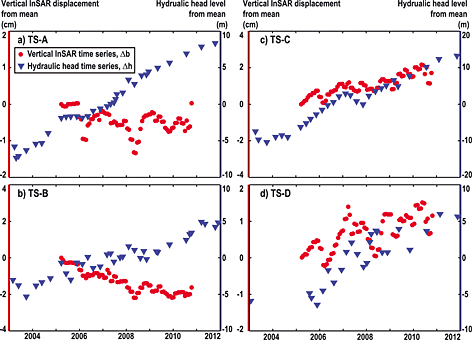A new paper by Megan Miller and Manoochehr Shirzaei at Arizona State describing subsidence in the Phoenix area offers some interesting new data for thinking about the implications of groundwater management. Subsidence is bad, and groundwater pumping is what causes it. Having the ground surface drop is bad all around, cracking building foundations, messing up roads, and such. What’s interesting about the Miller and Shirzaei paper is that it shows subsidence continuing long after groundwater overdraft stops. Here’s the key figure:

Groundwater levels (blue triangles) and surface elevation (red dots). From Miller, M. M., and M. Shirzaei (2015), Spatiotemporal characterization of land subsidence and uplift in Phoenix using InSAR time series and wavelet transforms, J. Geophys. Res. Solid Earth, 120, doi:10.1002/2015JB012017.
This is data from four key areas where the authors were measuring the earth’s surface rising or falling. The red dots are earth’s surface (rising in two areas, dropping in the other two) plotted against the levels of the underlying aquifer, which is rising in all four areas. As the authors explain, central Arizona, the area in and around Phoenix, pumped the hell out of its groundwater through most of the 20th century. That began to reverse with the passage of the state’s Groundwater Management Act in 1980, and there’s good evidence that in the decades since the overpumping has been reversed (see for example this paper from 2010 by a couple of USGS researchers which found 80 percent of the Phoenix area’s wells either stable or rising, and this one from the USGS’s Leonard Konikow, which also shows recovery in southern Arizona aquifers coinciding with the years after the GMA’s passage).
What’s interesting here is the wonky technical discussion of aquifer pore spaces and compaction that leads to the conclusion that subsidence is continuing in some areas even though the aquifer is rebounding.
